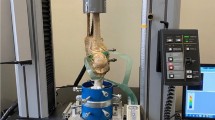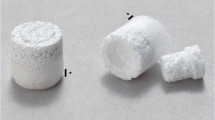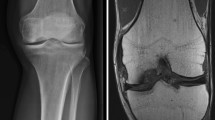Abstract
Introduction
Because articular cartilage shows little intrinsic capacity of spontaneous regeneration, a variety of treatment options are currently at use to repair cartilage damage. One of these is the autologous osteochondral transplantation (AOT). The aim of the present work was to study the histological changes during the progress of 1 year after AOT in the knee joint.
Materials and methods
Twelve Minipigs underwent an AOT on the medial femoral condyles of both knees using cooled diamond studded trephines with a diameter of the grafts of 4.6 mm. Three animals were sacrificed at each 2, 8, 26 and 52 weeks after the operation. The condyles were analyzed histologically and immunohistologically for collagen types I and II.
Results
A successful bony incorporation was observed in all specimens. The transplant demonstrated an increasingly stable integration of the chondral matrix into the cartilage of the surrounding femoral condyle. At 52 weeks after the operations 5 of 6 condyles showed a chondral integration at least at one side of the graft. Immunohistologically all specimens showed physiological staining characteristics up to 52 weeks after operation. The quality of the chondral part of the graft showed a wide range of variations, ranging from vital tissue resembling native cartilage after 52 weeks, to severe degenerative signs beginning 2 weeks after operation and ending at 52 weeks with deep fissures fragmenting the cartilage and the complete loss of vital cells.
Conclusion
The press-fit technique allows a stable bony incorporation. A chondral integration of the graft seems to occur, provided that a close contact between the interfaces can be achieved. Present results demonstrate a vital cartilagenous transplant for up to 52 weeks. However, some specimens showed in part severe degenerative signs. A possible explanation is an insufficient cooling of the trephines in relation to the small diameter of the grafts used in the minipig model. The collagen network seems not to be affected for up to 52 weeks.




Similar content being viewed by others
References
Barber FA, Chow JC (2001) Arthroscopic osteochondral transplantation: histologic results. Arthroscopy 17(8):832–835
Breinan HA, Minas T, Hsu HP, Nehrer S, Sledge CB, Spector M (1997) Effect of cultured autologous chondrocytes on repair of chondral defects in a canine model. J Bone Joint Surg Am 79(10):1439–1451
Brittberg M, Lindahl A, Nilsson A, Ohlsson C, Isaksson O, Peterson L (1994) Treatment of deep cartilage defects in the knee with autologous chondrocyte transplantation. N Engl J Med 331(14):889–895
Dallek M, Meenen NM, Jungbluth KH (1995) Zum Verhalten künstlich erzeugter Epiphysenfugendefekte, Teil 3: transplantation von autologem und homologem Rippenknorpel beim Göttinger Miniaturschwein (behavior of artificially induced epiphyseal groove defects. 3: transplantation of autologous and homologous rib cartilage in Gottingen minipigs. Findings after a 16 week interval). Unfallchirurgie 21(5):219–226
Evans PJ, Miniaci A, Hurtig MB (2004) Manual punch versus power harvesting of osteochondral grafts. Arthroscopy 20(3):306–310
Gillogly SD (2003) Treatment of large full-thickness chondral defects of the knee with autologous chondrocyte implantation. Arthroscopy 19(Suppl 1):147–153
Hembry RM, Dyce J, Driesang I, Hunziker EB, Fosang AJ, Tyler JA, Murphy G (2001) Immunolocalization of matrix metalloproteinases in partial-thickness defects in pig articular cartilage. A preliminary report. J Bone Joint Surg Am 83-A(6):826–838
Homminga GN, Bulstra SK, Bouwmeester PS, van der Linden AJ (1990) Perichondral grafting for cartilage lesions of the knee. J Bone Joint Surg Br 72(6):1003–1007
Horas U, Pelinkovic D, Herr G, Aigner T, Schnettler R (2003) Autologous chondrocyte implantation and osteochondral cylinder transplantation in cartilage repair of the knee joint. A prospective, comparative trial. J Bone Joint Surg Am 85-A(2):185–192
Hunziker EB (2001) Growth-factor-induced healing of partial-thickness defects in adult articular cartilage. Osteoarthr Cartil 9(1):22–32
Jackson RW, Dieterichs C (2003) The results of arthroscopic lavage and debridement of osteoarthritic knees based on the severity of degeneration: a 4- to 6-year symptomatic follow-up. Arthroscopy 19(1):13–20
Kääb MJ, Gwynn IA, Nötzli HP (1998) Collagen fibre arrangement in the tibial plateau articular cartilage of man and other mammalian species. J Anat 193(Pt 1):23–34
Lane JG, Massie JB, Ball ST, Amiel ME, Chen AC, Bae WC, Sah RL, Amiel D (2004) Follow-up of osteochondral plug transfers in a goat model: a 6-month study. Am J Sports Med 32(6):1440–1450
Lane JG, Tontz WL Jr, Ball ST, Massie JB, Chen AC, Bae WC, Amiel ME, Sah RL, Amiel D (2001) A morphologic, biochemical, and biomechanical assessment of short-term effects of osteochondral autograft plug transfer in an animal model. Arthroscopy 17(8):856–863
Lexer E (1908) Substitution of whole or half joints from freshly amputated extremities by free plastic operations. Surg Gynecol Obstet 6:601–609
Lorentzon R, Alfredson H, Hildingsson C (1998) Treatment of deep cartilage defects of the patella with periosteal transplantation. Knee Surg Sports Traumatol Arthrosc 6(4):202–208
Makino T, Fujioka H, Kurosaka M, Matsui N, Yoshihara H, Tsunoda M, Mizuno K (2001) Histologic analysis of the implanted cartilage in an exact-fit osteochondral transplantation model. Arthroscopy 17(7):747–751
Maruyama S, Hasegawa Y, Sakano S, Warashina H, Kitamura S, Yamauchi K, Iwata H (2003) Experimental evaluation of the usefulness of osteochondral allograft for articular cartilage defect. J Orthop Sci 8(4):560–566
Matsusue Y, Kotake T, Nakagawa Y, Nakamura T (2001) Arthroscopic osteochondral autograft transplantation for chondral lesion of the tibial plateau of the knee. Arthroscopy 17(6):653–659
Meenen NM, Rischke B (2003) Autogene osteochondrale transplantation (AOT) bei Knorpeldefekten am Femurkondylus [autogenous osteochondral transplantation (AOT) for cartilaginous defects of the femoral condyle]. Operat Orthop Traumatol 15(1):38–56
Messner K, Gillquist J (1996) Cartilage repair. A critical review. Acta Orthop Scand 67(5):523–529
Moseley JB, O’Malley K, Petersen NJ, Menke TJ, Brody BA, Kuykendall DH, Hollingsworth JC, Ashton CM, Wray NP (2002) A controlled trial of arthroscopic surgery for osteoarthritis of the knee. N Engl J Med 347(2):81–88
Nam EK, Makhsous M, Koh J, Bowen M, Nuber G, Zhang LQ (2004) Biomechanical and histological evaluation of osteochondral transplantation in a rabbit model. Am J Sports Med 32(2):308–316
Paulsen K (1976) Histologische Untersuchungen über mögliche Hitzeschäden an Knochen und Knorpel beim Bohren und Schleifen (Histological examinations about possible heat lesions of bone and cartilage during boring and grinding). Arch Otorhinolaryngol 212(1):35–41
Petersen JP, Ruecker A, von Stechow D, Adamietz P, Poertner R, Rueger JM, Meenen NM (2003) Present and future therapies of articular cartilage defects. Eur J Trauma 29(1):1–10
Peterson L, Minas T, Brittberg M, Lindahl A (2003) Treatment of osteochondritis dissecans of the knee with autologous chondrocyte transplantation: results at two to ten years. J Bone Joint Surg Am 85-A(Suppl 2):17–24
Pridie KH (1959) A method of resurfacing osteoarthritic knee joints. J Bone Joint Surg Br 41:618–619
Siebert CH, Miltner O, Schneider U, Wahner T, Koch S, Niedhart C (2001) Einheilungsverhalten von osteochondralen Transplantaten—Tierexperimentelle Untersuchungen an einem Schafmodell (healing of osteochondral transplants–animal experiment studies using a sheep model). Z Orthop Ihre Grenzgeb 39(5):382–386
Smith GD, Richardson JB, Brittberg M, Erggelet C, Verdonk R, Knutsen G, Ashton BA, Ashton IK, Harrison PE (2003) Autologous chondrocyte implantation and osteochondral cylinder transplantation in cartilage repair of the knee joint. J Bone Joint Surg Am 85-A(12):2487–2488
Steadman JR, Briggs KK, Rodrigo JJ, Kocher MS, Gill TJ, Rodkey WG (2003) Outcomes of microfracture for traumatic chondral defects of the knee: average 11-year follow-up. Arthroscopy 19(5):477–484
Steadman JR, Rodkey WG, Rodrigo JJ (2001) Microfracture: surgical technique and rehabilitation to treat chondral defects. Clin Orthop 391(Suppl):S362–S369
Störig E (1972) Knorpeltransplantation im Tierexperiment und Erfahrungen über ihre klinische Anwendung (cartilage transplantation in animal experiments and experiences with its clinical application). Z Orthop Ihre Grenzgeb 110:685–690
Temenoff JS, Mikos AG (2000) Review: tissue engineering for regeneration of articular cartilage. Biomaterials 21(5):431–440
Tibesku CO, Szuwart T, Kleffner TO, Schlegel PM, Jahn UR, Van Aken H, Fuchs S (2004) Hyaline cartilage degenerates after autologous osteochondral transplantation. J Orthop Res 22(6):1210–1214
Wagner H (1972) Möglichkeiten und klinische Erfahrungen mit der Knorpeltransplantation (Possibilities and experiences with cartilage transplantation). Z Orthop Ihre Grenzgeb 110:705–708
Ye J, Haro H, Takahashi M, Kuroda H, Shinomiya K (2003) Induction of apoptosis of articular chondrocytes and suppression of articular cartilage proteoglycan synthesis by heat shock. J Orthop Sci 8(3):387–395
Acknowledgments
The authors thank Cordula Müldner, Olga Winter and Marion Dietzmann for their technical assistance.
Author information
Authors and Affiliations
Corresponding author
Additional information
Klaus Baumbach, Jan-Philipp Petersen contributed equally to this work.
Rights and permissions
About this article
Cite this article
Baumbach, K., Petersen, JP., Ueblacker, P. et al. The fate of osteochondral grafts after autologous osteochondral transplantation: a one-year follow-up study in a minipig model. Arch Orthop Trauma Surg 128, 1255–1263 (2008). https://doi.org/10.1007/s00402-007-0532-3
Received:
Published:
Issue Date:
DOI: https://doi.org/10.1007/s00402-007-0532-3




